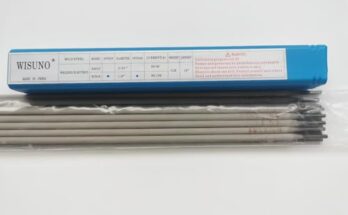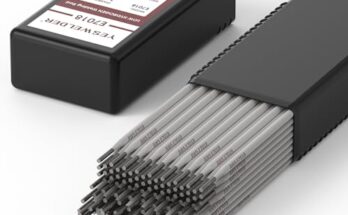Finding the right welding rod can make or break a project. This guide will help you understand what makes a 7018 rod excellent and how to choose the best one for your needs. We’ll explore different aspects, from understanding the 7018 designation to comparing top brands and considering specific applications.
The
designation “7018” tells us a lot about the rod. The “70” indicates its tensile strength (70,000 psi minimum). The “1” signifies its welding position – capable of welding in all positions (flat, horizontal, vertical, and overhead). The “8” reveals its classification as a low-hydrogen electrode, crucial for preventing hydrogen cracking in welds. Low-hydrogen electrodes are essential for high-strength applications where even tiny cracks can cause significant problems. Imagine building a bridge – you wouldn’t want a weld to fail due to a hidden crack! This is why understanding the 7018 designation is fundamental to choosing the right rod. Different applications demand different strengths and welding positions, so knowing what the numbers represent empowers you to make informed choices.
Key Features of a High-Quality 7018 Rod
A premium 7018 rod boasts several key features beyond just its tensile strength and low-hydrogen properties. Consistent arc stability is critical; a stable arc ensures a smooth, even weld bead, minimizing spatter and imperfections. Good slag removal is essential for optimal weld penetration and appearance. Imagine trying to paint a wall with thick, gloppy paint – the result is messy and uneven. Similarly, poor slag removal leaves a rough, uneven weld. Finally, the ease of arc starting directly impacts productivity. A rod that ignites easily and consistently saves time and effort, improving overall efficiency. These factors influence the quality of the weld, the speed of the process, and even the welder’s comfort. A welder spending hours wrestling with a difficult rod will experience fatigue and frustration, potentially affecting the quality of their work.
Comparing Different 7018 Brands and Manufacturers
The market offers a vast selection of 7018 welding rods from different manufacturers. Brands like Lincoln Electric, Hobart, and ESAB are well-known for their quality and reliability. Each manufacturer may have its unique formulations and manufacturing processes leading to subtle variations in arc characteristics, slag detachability, and other key performance indicators. Choosing a brand often comes down to personal preference and past experience. I personally found Lincoln Electric’s 7018 rods consistently reliable, providing a stable arc and easy slag removal – a crucial factor for me when working on intricate projects. However, others swear by Hobart or ESAB, depending on the specific application. It is a good practice to test different brands to determine which best suits your style and welding needs.
Factors to Consider When Choosing a 7018 Rod
Welding Application and Material
The choice of 7018 welding rod heavily depends on the application and material being welded. For instance, repairing heavy machinery might require a rod with higher tensile strength and improved toughness than what you would use for fixing a garden gate. Different steel types have varying compositions, meaning some rods perform better on certain materials. For example, a 7018 rod designed for low-carbon steel might not be as effective on high-strength alloy steels. Therefore, it is vital to carefully review the manufacturer’s specifications to match the rod to the material. Using the wrong rod can lead to weak welds, jeopardizing the structural integrity of the project.
Diameter and Length of the Rod
The diameter of the 7018 rod significantly impacts the weld bead size and penetration. Thicker rods are better suited for larger welds and thicker materials, requiring higher amperage. Conversely, thinner rods work well with thinner materials and require less current. The rod length also plays a role in welding efficiency. Longer rods minimize the time spent changing electrodes, increasing overall productivity. However, excessively long rods can become unwieldy and difficult to manage, affecting weld consistency. The choice of diameter and length depends on the specific needs of each project, involving balancing weld quality and welder comfort.
Cost and Availability
The price of 7018 rods varies between brands and suppliers. While some premium brands might command a higher price, their superior performance might justify the cost in terms of increased productivity and reduced material waste. It’s important to evaluate the overall cost-effectiveness, balancing initial price with performance and the potential for rework. Availability is another important consideration. Ensure that the chosen rod is readily accessible from local suppliers to minimize downtime during projects. Some niche or specialty rods might have limited availability or require longer lead times.
Advanced Considerations for 7018 Welding
Preheating and Post-Weld Heat Treatment
For critical applications, especially on thicker materials or low-temperature environments, preheating the base metal before welding is often recommended. Preheating helps to reduce cooling rates, preventing hydrogen cracking. Post-weld heat treatment can further enhance the weld’s toughness and durability. These practices may add extra time to the welding process but are crucial in ensuring optimal weld quality and longevity. Consider the specific material and project requirements to determine the necessity of preheating and heat treatment.
Welding Techniques and Parameters
Proper welding techniques and parameters (current, voltage, travel speed) significantly influence the final weld quality. Maintaining a consistent arc length, appropriate travel speed, and precise control over the welding parameters are essential for producing high-quality welds. In my experience, experimenting with different parameters and techniques to find the optimal settings for your chosen rod and material is vital. Mastering these techniques ensures consistent weld quality and reduces the possibility of defects.
Safety Precautions
Welding with 7018 rods, like any welding process, requires strict adherence to safety precautions. Always wear appropriate personal protective equipment (PPE), including a welding helmet with appropriate shade, gloves, and protective clothing to shield yourself from intense heat and UV radiation. Proper ventilation is crucial to avoid inhaling harmful fumes. Understanding and following safety guidelines minimizes the risk of injury and ensures a safe working environment.
7018 Welding Rod Applications
Industrial Applications
7018 welding rods are extensively used in various industrial applications, including heavy machinery repair, pipeline construction, and structural fabrication. Their exceptional strength and crack resistance are critical for these applications where structural integrity is paramount. The rods are particularly suitable for welding thick sections of steel in various positions. The consistent quality and reliability of 7018 rods make them the preferred choice for many industrial welders.
Maintenance and Repair
The versatility of 7018 rods makes them invaluable in maintenance and repair operations. From repairing heavy-duty equipment to restoring damaged structures, 7018’s ability to produce strong, durable welds ensures the longevity and safety of repaired components. The rod’s low-hydrogen properties prevent cracking, a significant concern in maintaining critical equipment. Using 7018 ensures long-lasting, reliable repairs.
Specialized Applications
While commonly used in general steel welding, 7018 rods find niche applications in specialized fields as well. Certain formulations can handle welding in cryogenic conditions or high-pressure environments. This versatility makes 7018 a crucial welding material across diverse industries requiring high strength and durability in their welded components. This adaptability extends the usefulness of this versatile rod far beyond common steel welding jobs.
Choosing the Right Electrode for Your Project
Analyzing Your Specific Needs
Before selecting a 7018 rod, meticulously assess your specific project requirements. Consider factors like the material thickness, welding position, the desired weld strength, and the environment the weld will endure. This careful analysis ensures optimal performance and avoids potential issues stemming from improper electrode selection. It is critical to accurately determine the necessary strength, durability, and position capabilities before making a purchase.
Considering the Cost-Benefit Ratio
While higher-priced 7018 rods sometimes offer improved performance, cost is still a crucial factor. Weigh the advantages of premium rods against their increased price, factoring in potential savings from increased productivity, reduced rework, and minimized material waste. The cost-benefit analysis enables an informed choice that balances performance and budgetary constraints.
Seeking Expert Advice
If you are unsure about choosing the correct 7018 rod for your project, seeking advice from experienced welders or welding supply professionals is highly recommended. They can help identify the optimal rod based on your specific requirements, saving time, materials, and preventing costly mistakes. An expert’s perspective can significantly enhance the outcome of your project.
Frequently Asked Questions
What is the best 7018 welding rod best for?
The best 7018 welding rod depends on the specific application. However, its low-hydrogen properties and all-position capabilities make it ideal for critical welds where strength and crack resistance are paramount. It’s excellent for structural steel, heavy equipment repair, and pipeline welding. Learn more about specific applications of 7018 rods.
What are the differences between various 7018 manufacturers?
While all 7018 rods adhere to the same basic specifications, manufacturers may utilize slightly different formulations and production techniques. This can lead to variations in arc stability, slag detachability, and ease of use. Some manufacturers might focus on producing a rod with an exceptionally smooth arc, while others emphasize ease of slag removal. Testing different brands is often the best way to find your preferred manufacturer.
How important is proper preheating when using 7018?
Preheating is crucial for preventing hydrogen cracking, especially in thicker materials or low-temperature environments. The preheating temperature depends on the material and thickness; insufficient preheating can lead to weld defects. Consult the manufacturer’s guidelines and relevant welding codes for proper preheating recommendations.
Can I use 7018 on all types of steel?
While 7018 is versatile, it’s primarily designed for carbon steel. Its suitability for other steel types, such as stainless steel or high-strength alloys, depends on their specific composition and the required weld properties. Always consult the manufacturer’s recommendations to ensure compatibility.
What safety precautions should I take when welding with 7018?
Always wear appropriate PPE, including a welding helmet with the correct shade, gloves, and protective clothing. Ensure adequate ventilation to avoid inhaling harmful fumes. Follow all relevant safety guidelines to prevent injuries.
How do I determine the correct amperage for 7018?
The appropriate amperage depends on the rod diameter, material thickness, and welding position. Consult the manufacturer’s specifications or a welding data sheet for recommended amperage settings. Always start at the lower end of the recommended range and adjust as needed.
What is the shelf life of a 7018 welding rod?
The shelf life of 7018 rods depends on proper storage conditions. If stored correctly in a dry location, they generally have a shelf life of several years. However, it’s advisable to check the manufacturer’s recommendations and inspect the rods before use for any signs of deterioration.
Final Thoughts
Choosing the best 7018 welding rod involves considering several factors, from the specific application and material to the brand and cost. By understanding the characteristics of 7018 electrodes and carefully assessing your needs, you can ensure a strong, durable, and reliable weld. Remember to prioritize safety, practice proper welding techniques, and always consult relevant codes and standards. With the right knowledge and preparation, you can achieve professional-quality welds with 7018 rods. Start your next project with confidence knowing you’ve chosen the right tools for the job!


